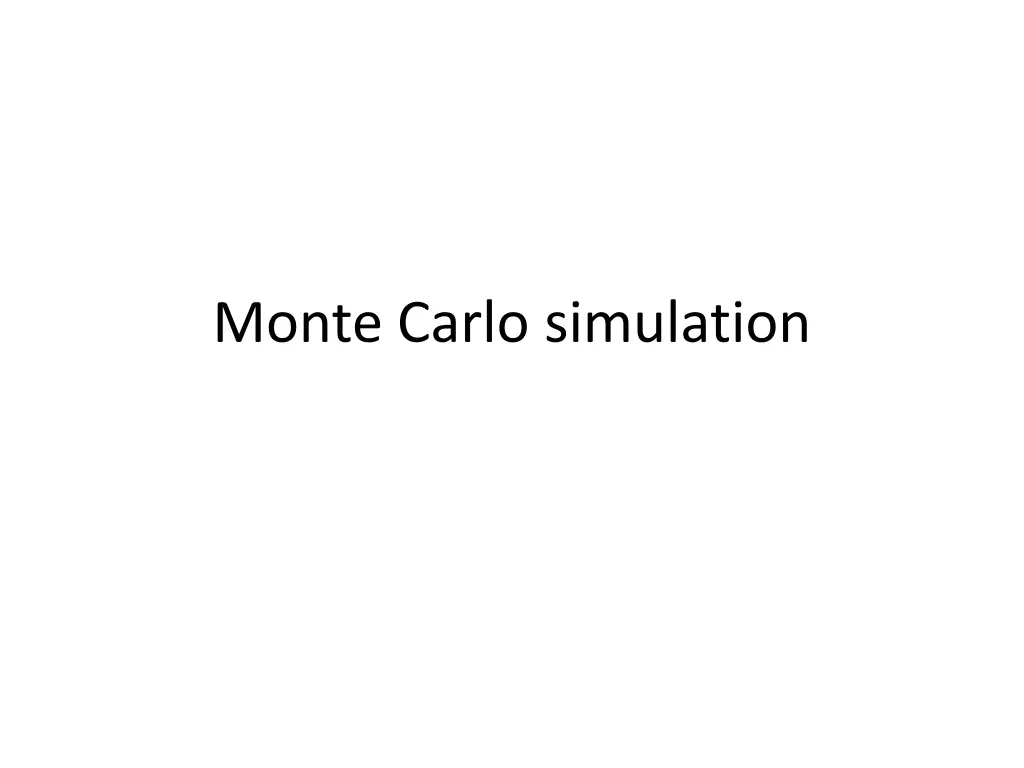
Advanced Raycasting Techniques
Explore advanced raycasting techniques including Monte Carlo simulation, isosurface raycasting, shading, lighting effects, and alpha blending in 3D visualization. Learn how to enhance rendering quality using lighting and shading methods.
Download Presentation

Please find below an Image/Link to download the presentation.
The content on the website is provided AS IS for your information and personal use only. It may not be sold, licensed, or shared on other websites without obtaining consent from the author. If you encounter any issues during the download, it is possible that the publisher has removed the file from their server.
You are allowed to download the files provided on this website for personal or commercial use, subject to the condition that they are used lawfully. All files are the property of their respective owners.
The content on the website is provided AS IS for your information and personal use only. It may not be sold, licensed, or shared on other websites without obtaining consent from the author.
E N D
Presentation Transcript
Isosurface raycasting (visualization.cl) __kernel void isosurface(const int width, const int height, __global float4* visualizationBuffer, const int resolution, __global float* volumeData, const float isoValue, const float16 invViewMatrix){ // Images space coordinates int2 id = (int2)(get_global_id(0), get_global_id(1)); float2 uv = (float2)( (id.x / (float) width)*2.0f-1.0f, (id.y / (float) height)*2.0f-1.0f ); // Bounding box of the model in the 3D space float4 boxMin = (float4)(-1.0f, -1.0f, -1.0f,1.0f); float4 boxMax = (float4)(1.0f, 1.0f, 1.0f,1.0f); // Ray in the 3D space struct ray eyeRay; eyeRay.origin = (float4)(invViewMatrix.sC, invViewMatrix.sD, invViewMatrix.sE, invViewMatrix.sF); float4 temp = normalize(((float4)(uv.x, uv.y, -2.0f, 0.0f))); eyeRay.direction.x = dot(temp, ((float4)(invViewMatrix.s0,invViewMatrix.s1,invViewMatrix.s2,invViewMatrix.s3))); eyeRay.direction.y = dot(temp, ((float4)(invViewMatrix.s4,invViewMatrix.s5,invViewMatrix.s6,invViewMatrix.s7))); eyeRay.direction.z = dot(temp, ((float4)(invViewMatrix.s8,invViewMatrix.s9,invViewMatrix.sA,invViewMatrix.sB))); eyeRay.direction.w = 0.0f; float4 color = (float4)(0.0f); // Intersecting the bounding box with the ray float tnear, tfar; int hit = intersectBox(eyeRay.origin, eyeRay.direction, boxMin, boxMax, &tnear, &tfar); if(hit){ // TODO color = (float4)(1.0f); } // Writing the result color the image buffer if(id.x < width && id.y < height){ visualizationBuffer[id.x + id.y * width] = color; } }
Isosurface raycasting Step between tnear and tfar Calculate the current position in the 3D space Read the density (getDensityFromVolume) If the density is greater than isoValue, than the color shall be (float4)(1.0f) Exit from the loop
Isosurface raycasting Let`s add shading Light direction: 0.3, -2.0, 0.0, 0.0 To get the normal vector in the volumetric model, use the getNormalFromVolume function Color is defined as: clamp(dot(lightDir, normal), 0.0, 1.0)
Isosurface raycasting Hemisphere lighting Color: 0.5f + 0.5f * dot(lightDir, normal)
Alpha blended raycasting (visualization.cl) __kernel void alphaBlended(const int width, const int height, __global float4* visualizationBuffer, const int resolution, __global float* volumeData, const float alphaExponent, const float alphaCenter, const float16 invViewMatrix){ int2 id = (int2)(get_global_id(0), get_global_id(1)); float2 uv = (float2)( (id.x / (float) width)*2.0f-1.0f, (id.y / (float) height)*2.0f-1.0f ); float4 boxMin = (float4)(-1.0f, -1.0f, -1.0f,1.0f); float4 boxMax = (float4)(1.0f, 1.0f, 1.0f,1.0f); // calculate eye ray in world space struct ray eyeRay; eyeRay.origin = (float4)(invViewMatrix.sC, invViewMatrix.sD, invViewMatrix.sE, invViewMatrix.sF); float4 temp = normalize(((float4)(uv.x, uv.y, -2.0f, 0.0f))); eyeRay.direction.x = dot(temp, ((float4)(invViewMatrix.s0,invViewMatrix.s1,invViewMatrix.s2,invViewMatrix.s3))); eyeRay.direction.y = dot(temp, ((float4)(invViewMatrix.s4,invViewMatrix.s5,invViewMatrix.s6,invViewMatrix.s7))); eyeRay.direction.z = dot(temp, ((float4)(invViewMatrix.s8,invViewMatrix.s9,invViewMatrix.sA,invViewMatrix.sB))); eyeRay.direction.w = 0.0f; float4 sum = (float4)(0.0f); float tnear, tfar; int hit = intersectBox(eyeRay.origin, eyeRay.direction, boxMin, boxMax, &tnear, &tfar); if(hit){ sum = (float4)(1.0f); } if(id.x < width && id.y < height){ visualizationBuffer[id.x + id.y * width] = (float4)(sum); } }
Alpha blended raycasting X-Ray image Step from tfar to tnear Sum the density according to the absorption Alpha = pow(density, alphaExponent) * step Sum = (1-alpha)*sum + alpha * (float4)(1.0)
Alpha blended raycasting Add shading Step from tfar to tnear Sum the lighting while taking the absorption into consideration Density: getDensityFromVolume Normal vector: getNormalFromVolume Alpha: clamp(alphaExponent * (density alphaCenter) + 0.5, 0.0, 1.0 Color: 0.5f + 0.5f * dot(lightDir, normal) Color sum: (1-alpha) * sum + alpha * color
Alpha blended raycasting Using a transfer function color *= (float4)(density, density * density, density * density * density, 1.0f) + 0.1f;
